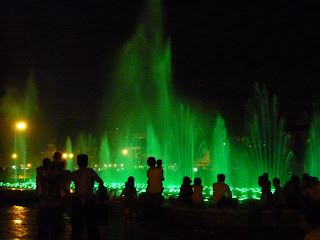It's our last night in Phnom Phen. I'm behind - I haven't told you about our wonderful trip to Roteang. I'll do that next. But I want to tell you about our last day here while the images are fresh.
Tonight we walked back from dinner. It was a lovely night - hot and humid, but filled with gentle breezes and tons of people out having a good time. We strolled along crowded sidewalks and crowded parks, watching colored fountains give us a light and sound show. Crossing streets was a challenge. Mom insisted that we couldn't get killed on the last night of our trip. With so much traffic and no street signs, crossing is an art. We'd watch for gaps, then confidently edge into them. And miraculously, it always worked out. We also kept promising mom that when she couldn't take it anymore, we'd get a tuk tuk the rest of the way home. But she persevered, and we walked all the way home. I was glad for the walk before we sit for umteen hours tomorrow.
This morning we bravely ventured forth to the Killing Fields. At our hotel they strongly advised going to the Killing Fields museum first, a high school that was used to torture people during the Khmer Rouge. Once people had given up the names of their families, they were sent, along with those families, to be killed outside of town. We decided that we could handle the grim subject if we were outside in the sunshine, but not in a dark high school.
In case you're lacking in this history lesson (I was), here's a short summary. In 1975, Pol Pot decided that Cambodia should become an agrarian communist society. He systematically targeted all intellectuals, doctors, lawyers, teachers, and even people who wore glasses. He emptied the cities, sending people out to the countryside. Between 1975 and 1979, somewhere between 1.7 and 3 million people were killed, either directly (killing fields) or indirectly (starvation, lack of medical care, landmines, etc.). The population of Cambodia at the time was 7-9 million, so this was a huge loss. Eventually the Vietnamese came to liberate Cambodia and stop the killings, but all sorts of awful things continued for awhile.
Even those this happened over 30 years ago, there are all sorts of impacts we can still see on Cambodia. The biggest thing is the education problem. If you'd survived the Khmer Rouge, do you think you'd want your kids to go to school or end up appearing to be an intellectual? Probably not. Also, all the teachers were gone. So there is a huge education gap that hasn't been fixed yet.
In addition, I see a huge population problem. 30 years ago there were 7-9 million people here. After the Khmer Rouge, there were still 4-6 million people. Now there are around 14 million. I can believe it. Families seem to commonly have 4-6 kids, often more. We've seen a LOT of kids here! Both Elephant and Mr. Sambah believe that the solution to overpopulation is education. I think they're right. Educate the kids, and they won't get married and have their first kids at 14 or 16. If these kids get jobs other than farming, they won't need so many kids to help out. In fact, they will naturally opt for fewer kids and more opportunities for each kid. So when we get home, we'll be sending money to both of the programs we visited. They're both grass-roots efforts to make big change at a village level, both directly, and by providing inspiration and example.
Well, that's it for now. We head home in the morning. It's odd - we leave Phnom Phen around noon, and arrive (hopefully) in Minneapolis around midnight. It sounds like the journey takes 12 hours, or 36 hours, but actually it takes 24 hours. Go figure that out!






No comments:
Post a Comment